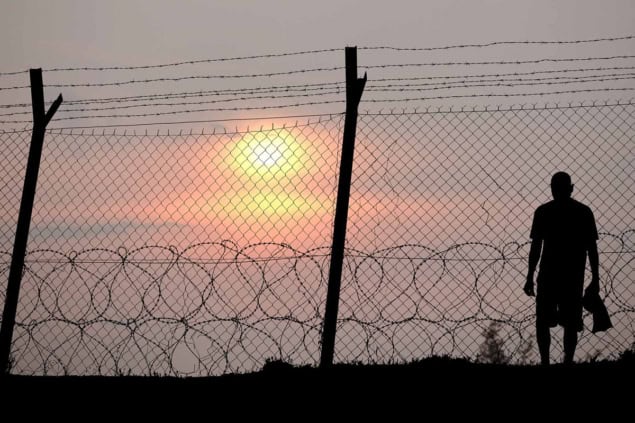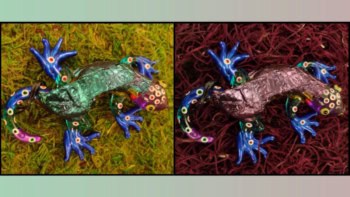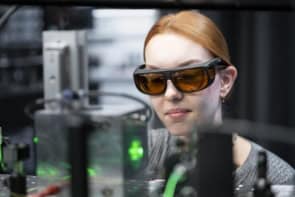A novel sound-detection technique based on fibre-optic and laser technologies can be used to detect intruders, check the flow in pipelines and monitor undersea wildlife, reports Katia Moskvitch

Hidden underground beneath international borders and military zones, a new form of stealth technology is taking root. In a technique known as distributed acoustic sensing, the same type of fibre-optic cables that we use for telephony and the Internet are being used as highly sensitive arrays of buried acoustic sensors. Being developed by a number of different firms, these systems can be used to remotely listen out for illegal immigrants crossing international borders, trespassers walking towards a military base, people tampering with oil or gas pipelines, or criminals damaging railway lines.
In the technique, sounds are “heard” by sending pulses of coherent laser light down an optical fibre and analysing the very small signal that is both scattered and reflected back along the fibre. Scattering and reflection occur at every point along the length of the fibre, so the original laser pulse comes back as thousands of very weak overlapping laser pulses. If there are no sounds to detect, the returning signal shows nothing special. But in the presence of a sound it has characteristic features that can be identified as footsteps, for example, or even a drone flying overhead.
The light in the fibre is scattered in all directions – including back along the direction from which it came – because it hits tiny imperfections such as density fluctuations. Known as Rayleigh scattering, this phenomenon is most familiar to us when sunlight passes through the atmosphere and is responsible for the sky appearing blue. “The atmosphere has random fluctuations of density and refractive index from place to place on a small scale due to small particles and molecules in the atmosphere,” says David R Selviah of University College London, who has been involved in commercializing distributed acoustic sensing (DAS). “These random fluctuations cause light to be scattered in all directions.”
But light is also sent back where one piece of cylindrical fibre ends and another begins. Where sound waves come into the picture is that when they pass through the fibre, they cause it to flex ever so slightly, which changes the fibre’s local optical properties. The signal that is scattered and reflected back along the cable is then also altered and it is this pulse modulation that companies are exploiting to develop highly sensitive systems based on DAS. The exterior sound modulates the reflected laser pulses, and once the laser pulses are received, the sound can be extracted from them. As Selviah puts it, such systems essentially work as a distributed underground array of microphones.
The source of a sound can be pinpointed spatially to within tens of metres – which is a good accuracy considering that the optical fibres can be as long as 50 km
Using DAS, the source of a sound can be pinpointed spatially to within tens of metres – which is a good accuracy considering that the optical fibres can be as long as 50 km. “We can tell which point in the fibre reflected which pulse by noting the time that each pulse returns,” explains Selviah, who has in the past worked on the signal processing and pattern-recognition analysis of data from DAS systems for Silixa – a UK-based fibre-optics firm founded in 2007 that operates in the energy, security and industrial sectors. Uses of DAS in these areas include detecting earthquakes and Earth tremors, and hearing the creaking sounds of buildings, bridges or dams to see if they are deteriorating.
Sound interpretation
1 Suspicious sounds
Using distributed acoustic sensing, sensitive areas such as borders and railway lines can be monitored for warning signs of criminal activity. Shown here, left to right, are the tell-tale signs of gunfire, digging, a vehicle, a person walking and a microlight (a small aeroplane).
Another firm leading the development of DAS systems is OptaSense – a subsidiary of the UK technology group QinetiQ. OptaSense this year won Queen’s awards for both innovation and international trade, and if you visit its headquarters in Farnborough, south-west of London, you’ll see computer screens showing complicated zigzagging lines, similar to those a seismograph would show when picking up Earth tremors. These lines represent ground vibrations, and a car passing above the buried fibre-optic cables generates more lines than footsteps.
These lines are essentially the raw exterior acoustic data, and the control centre’s job is to use high-speed signal-processing algorithms to extract the information relevant to the user’s problem in real time, says David Hill, OptaSense’s chief technology officer. The data are then relayed for integration with other sensors, or sent to users via their mobile devices. Besides detecting footsteps to within roughly 10 m either side of a fibre-optic cable, DAS can even spot a low-flying drone overhead. The sounds can be displayed as shown in figure 1, but they can also be played out loud and made to sound like the original noise, using a bit of signal processing and programming.
Listening for leaks

One sound that many companies are listening out for using DAS is oil or gas flowing along a pipe or in a well – in particular to check for leaks. In this case, rather than the optical fibres being buried underground, they are inserted into a well bore. Both Hill and Selviah think this is an especially exciting application area for DAS.
That view is echoed by Kari Anne Kjolaas-Holland, business development manager for microseismic services at Schlumberger, which supplies technology services to the oil and gas industry. The company uses DAS to sense an entire well at one time for vibration, temperature, strain and so on. “Without moving the down-hole cable, a snapshot of the properties in the well may be collected instantly, like a photograph,” Kjolaas-Holland explains. “We see both the big picture and fine details in each snapshot, and by combining successive pictures, it becomes very much like watching a movie.”
Before DAS came on the scene in the late 2000s, oil and gas firms had to place arrays of microphones into wells and pipes. Time on the oil or gas rig had to be set aside for this specific activity, and multiple sparse measurements had to be taken by moving the microphones along the length of the well bore. For this purpose, DAS is a game changer. DAS systems can be permanently installed so that conditions in the well are monitored all the time, with the sound being sensed almost continuously along the entire length of the well.
Ships, sharks and submarines
Although DAS is barely able to pick up a conversation, Selviah thinks that might one day change. It is already being buried in roads to listen to cars passing to determine exactly where they are, and – as it develops further – it could also work in buildings. With sufficient future developments, these optical fibres could even, Selviah adds, be inserted into blood vessels to listen to the flow of blood and the heart during operations.
Marine physicist Philippe Blondel of the University of Bath is one researcher who thinks the technology could also be used to make cheap hydrophones – underwater microphones, developed for recording or listening to underwater sounds. Water is a compressible medium, and applying pressure to it will create pressure further away. So any change in water pressure, for example by creating sound, will be picked up by the DAS systems.
Current hydrophones look for a full range of frequencies, and the signal they produce then needs to be processed to extract the frequencies of interest. But with a DAS sensor, it might be possible to design it so that only very specific frequency bands can be detected. It could then be used to listen for ships, submarines or radar instruments on the seabed that “ping” a particular signal – for military, navigation or commercial monitoring purposes.
As an advanced application, these underwater DAS microphones could also be used to identify and monitor fish, sharks or other animals based on the sound they generate under water or on the ground. If these sensors had been implemented under water in the right area, then – who knows – perhaps they could even have been used to look for the Malaysian aeroplane that mysteriously went missing in March this year.




